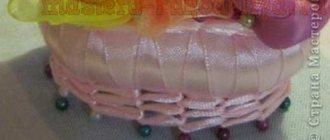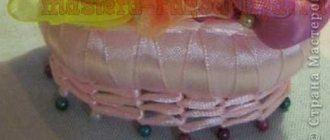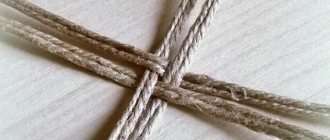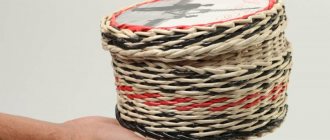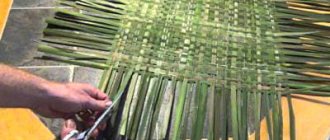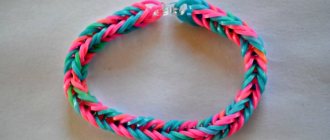The art of creating various products from wicker or willow twigs was known more than a thousand years ago. At that time, this was a necessary skill related to satisfying a person’s everyday needs.
Currently, weaving willow baskets for beginners and experienced craftsmen is, rather, an exciting hobby that allows you to get beautiful products intended not only for collecting and storing mushrooms, berries, fruits and vegetables, but also for decorating rooms.
Modern designers are increasingly resorting to the use of all kinds of baskets, as they make it possible to fill the space with a unique rustic “spirit” and coziness, inherent only in rural houses. This is especially true in rustic, country and ethnic style interiors, which are now becoming increasingly popular among residents of various private houses.
Why does a modern person need a wicker basket?
It seems that baskets are of no use now. There are convenient bags and backpacks, plastic shopping bags. But braids are no less popular than in the old days. Now they can become an original interior detail, especially in a country house or country house. But even in a city house, the work of a true master will look stylish and appropriate.
On the Internet you can find many photos of wicker willow baskets with fruits or flowers in the interiors of various rooms. Want to decorate your home with the same element?
Nothing could be easier! Step-by-step instructions will help you master the basics of weaving. Perhaps you will like it so much that you will decide to move from baskets to more complex products: vases, bread bins and even furniture.
Decorative model
This rectangular basket is made of veneer; the product has no handles, because it serves as an interior decoration. You can put various small things in the container, which will complement the aesthetics of the room; you can also store fruits or balls of thread.
Before starting the process, you need to prepare the following:
- Sufficient quantity of veneer.
- Scissors.
- A few clothespins.
- Ruler for measurements.
Stages of work:
- The base material is pre-soaked in water at room temperature, one hour will be enough, after which the strips are hung to drain excess liquid.
- At the next stage, the blanks are cut to the selected sizes; you should strictly adhere to the divisions on the ruler to avoid mistakes.
- For trouble-free weaving, you need to secure several strips with tape or a book, and when you reach the top, use clothespins, otherwise the craft will begin to fall apart.
- There is no need to cut off excess veneer from the edges, just tuck them in and make sure they are securely fastened.
Wicker weaving basics
Modern products woven from willow branches are very popular. They decorate not only summer cottages, but also city apartments. In addition, they not only bring practical benefits, but also decorate the room.
It should be added right away that collecting branches for weaving does not harm the tree. On the contrary, it is able to rejuvenate and improve his health. This type of needlework is popular not only in villages, but also in big cities. It’s especially nice that willow weaving is an absolutely inexpensive hobby, because you can collect the necessary material yourself.
Willows are widespread in Russia. Therefore, finding a tree and collecting material will not be difficult. If you don’t want to do it yourself, then willow vines can be purchased in specialized stores that offer handicraft supplies.
Care of finished products
Products made from wicker do not require special care. They should be stored in a dry, cool place so that the rods do not dry out and the product does not become deformed.
The product should be cleaned with a clean, dry piece of cloth, and dried thoroughly if a large amount of water gets in contact with it. Grease stains can be removed using powder or talcum powder and a small amount of mild detergent.
As you can see, there is nothing complicated in one of the oldest crafts. The main thing is to get good at weaving and use high-quality raw materials. The reward for your efforts will be the beautiful, always up-to-date interior of your apartment or house.
Basket weaving technology
To weave a basket, you can purchase ready-made willow twigs or assemble them yourself.
Freshly cut rods filled with juice must be dried well, and before starting to weave the product, soak for 30-40 minutes in hot water to make them more flexible.
The tools you will need for the job are pruning shears, a sharp pocket knife, scissors and an awl or screwdriver.
The art of basket weaving has its own simple terminology. If you look at the bottom of the basket, you will see thick straight rods that radiate from the center in the form of rays and are called “spokes.” Once they are folded upward to form the walls of the basket, they become the “racks” (or “box”).
All the sections of thin willow rods that bend between the spokes and posts are called "knit" (or "weave/weft"). Usually baskets begin to be woven from the bottom. Sometimes it is also called the base. Then the walls, bends and, if necessary, handles are woven.
We weave the walls of the basket
Once you get the hang of it, you can explore different basket weaving patterns. It’s better to start with the simplest one-by-one. It uses two strapping rods, alternately covering the racks from the inside and outside.
It is important to remember to tighten the weave tightly and not to add both new twigs at the same time. It is optimal to change the second one after the first one has already passed half a circle.
Another important point is the thickness of the tail. Do not try to stretch the rod as long as possible. As soon as it becomes too thin, trim and replace. Having raised the walls to the required height, make several rows in the same way as when connecting to the bottom.
Required tools and materials
Wicker weaving is a type of needlework that uses natural materials. Processing large quantities of raw materials may require a special machine, but in most cases you can do without it. At different stages of making a basket, the craftsman will need the following tools:
- pruner;
- manual or electric jigsaw;
- a sharp knife with a beveled blade;
- tailor's or gardening scissors;
- drill;
- spacious containers for soaking rods;
- pliers;
- durable clothespins;
- tweezers;
- brushes, varnish, stain.
The main material needed to make a basket is willow twigs. They are easy to obtain yourself; some craftsmen even grow raw materials on their own site, selecting the best varieties and types of shrubs. You can also buy prepared materials in the store. When preparing yourself, you should consider a number of basic recommendations.
- The best raw materials are obtained on loamy and sandy soils. You should choose young, healthy bushes with long, straight shoots.
- Secateurs are used for harvesting. The longest shoots that do not have a large number of lateral branches should be selected.
- The cut is made at an angle. It is important to leave a few buds under the line along which the raw materials are collected.
- Only branches with a narrow, dense core are used. A loose middle part indicates that the material is too old for wicker weaving.
- Check raw materials during procurement. To do this, 1 branch is cut, the resulting material is bent 180 degrees. If it can withstand the load without cracking or breaking, the vine is considered suitable for weaving.
- Observe the recommended thickness. For the bottom of the baskets, solid rods are taken; for the walls, the material is split into thinner elements.
The optimal time for preparing suitable rods is when sap flow is minimal.
Shoots cut in March-April are easily cleared of bark without additional effort. Material collected at other times will have to be soaked or scalded before processing. It is worth considering that after such treatment the shoots will acquire a glossy shine and will be reliably protected from darkening and exposure to moisture. The rods that have not been boiled will gradually darken and lose their decorative effect.
Seal the Christmas wreath
When there is a base, all that remains is to add a little thickness - on top of what we wove initially, we add new branches according to the same pattern - we braid new branches on top of this structure, lighting them around the base.
After adding several branches, your wreath will become thicker and more voluminous, then it all depends on your desire and availability of materials - you can weave a small dense wreath, you can make a large wreath with thin frames, it’s whatever you like. The main thing is a solid foundation that will allow you to add new branches and improve the design as a whole.
Harvesting willow vines
As a rule, a young one-year-old rod is prepared for weaving. The cutting technique is quite simple: use a sharp knife or garden shears (secateurs) to cut the vine at the base at an angle of 30-60 degrees. The sharpness of the blade is important, as the cut must be smooth, without chipping. This not only makes further processing of the rod easier, but also prevents the hemp from rotting.
Based on the period of the year, there are two main periods for harvesting vines: spring-summer and autumn-winter. The best time for harvesting during the growing season is July-August, when the rod is already ripe, has become strong enough and is easy to clean with a pinch and does not require additional processing. In addition, the summer rod has a bright white wood color. But along with the advantages: ease of harvesting and processing, the summer vine has disadvantages: the wood is not yet completely strong and such a vine breaks quite often. After debarking, the summer rod should be spread out in a thin layer in the sun, in a place well blown by the wind, so that it dries well. Dried vines should be sorted by length, diameter or willow variety. It is usually easier to sort vines into three types: large, medium and small. Large - rods with a length of 1200 mm and a butt thickness of 0.8-1 cm, medium ones with a length of up to 1000 mm and a thickness of 0.5-0.8 mm, small ones - up to 800 mm and a thickness of up to 0.5 mm.
It is important to store the rod in a dry place in bunches according to variety. If the vine is not dried enough, it may become moldy and darken. Uncleaned twigs are not preserved in summer. It dries quickly and becomes unsuitable for weaving. For this reason, only peeled rods are harvested in the summer.
Autumn-winter vine, harvested starting from the end of October, when the leaves fall and sap flow stops. You can cut willow in winter, unless, of course, deep snow prevents you from getting to the plantations. The rod of autumn-winter harvesting has strong, flexible, elastic wood. The bark on it holds firmly, which is convenient for weaving from uncleaned vines. But it is difficult to clear such a vine of bark.
Time of year for harvesting and processing rods
Rods for willow weaving are harvested all year round, but preferably in early spring and late autumn. The bark of spring shoots can be removed very easily without additional processing.
Twigs collected in another season need to be soaked or evaporated.
To soak, the shoots are dipped into running water - a river or stream, after having been secured to the shore with a rope so that they do not get carried away by the current. You can use it in a trough or barrel, but in this case a daily change of water is required. Tied bunches with shoots are immersed to the bottom, and a load is placed on top (a stone or any other heavy object except iron) and left for 1–2 weeks.
To reduce processing time from several weeks to several hours, instead of soaking, the rods are evaporated in any of two ways:
The shoots are placed in a tank, rolled up around the perimeter, filled with water and put on fire. After boiling, cook for 1–2 hours. Then take it out, let it cool and begin removing the bark.
The vine is no longer poured with cold water, but with boiling water, brought to a boil and boiled for 20–30 minutes. Take it out, cool it and remove the bark. It is better to clean the rods raw, starting from the butt (root part). During cleaning, to prevent the material from drying out, it is better to leave it in water and remove it in small bunches.
After the willow has been debarked, to finish the job, it must be laid out in the sun until completely dry. For ease of use, the rods are sorted and folded into bundles of equal size.
Barked rods are divided into two types - those prepared in the spring and those obtained by digestion. Boiled during use, they acquire a bright, glossy appearance, are easy to clean, and become better each time.
Uncooked ones, on the contrary, darken over time, acquiring a nondescript appearance.
Preparing the vine
Before weaving, the willow needs to be prepared. First, the bark is removed from the branches, and then it is allowed to dry for 5 days. It is best to leave the material outdoors. After the time has passed, when the willow branches are prepared and dry, they begin to work.
It should immediately be noted that when weaving a basket, a special technology is used, namely:
- the bottom and edges are woven with long solid rods;
- for the walls they use vines split into several parts.
For splitting you will need a special cleaver, which is made from hard wood. First, take a twig, at the very tip of which you need to make a small incision. The cleaver is inserted into it. Due to these actions, the branch is split into several parts.
After this, the split part is placed in water for several hours, and when taken out, the brown center is removed from it.
To properly process the split rod, it is recommended to use a plane. During work, the material will have to be constantly moistened; for this you can use a spray bottle or keep the branches in water and, if necessary, remove them.
As soon as enough willow has been prepared, you can proceed directly to weaving from willow twigs. It is better for beginning needlewomen to first familiarize themselves with some master classes.
Fabric baskets
Fabric baskets can be used for useful purposes, for example:
- as a laundry basket;
- containers for storing children's toys;
- stands for newspapers and magazines;
- boxes for needlework;
- covers for flowerpots and much, much more.
To create a basket, both plain and colored fabric is suitable. From the prepared fabric you need to cut two circles and two rectangles, the length of the rectangle should be equal to the perimeter of the circle. Fold the blanks back to back and stitch the circle to the rectangle. The basket is ready.
Finishing is at the discretion of the master; beautiful bows, flowers, lace, etc. will do. Such baskets can be decorated in Easter style, put Easter and eggs in it and take it to the temple for consecration.
Step-by-step diagram for making a basket
Before you start weaving, you need to moisten the willow twigs. To do this, you can use a spray bottle, or simply place the prepared material in a deep container of water. Once the required amount of willow has been prepared, you can begin to work. To create a shopping cart you must complete the following steps:
- At the very beginning, you need to split 5 long and solid branches, and then insert 5 more new branches into these split holes. Then you need to insert the ends of the first two branches into the same holes.
- The next step is to braid the bottom. To do this, you need to take the first twig and cover the split branches from above, and using the second twig, cover those located below.
- The same manipulations are done with the third and fourth vines.
- Then you need to spread the crosspiece rods, giving them the shape of a fan, and braid them with two willow branches.
- After this, you need to press the braided branches against each other. The easiest way to do this is with a tailor's awl.
- After the bottom is woven to the required size, you need to proceed to installing the ribs of the basket. To do this, you need to take round willow rods, cut off their ends along an oblique line, but this must be done at a distance of about 5 cm. Then the sharp ends must be inserted into the bottom braid, and all excess ends must be carefully trimmed.
- The edges of the bottom are woven from 4 round branches of willow, which must be inserted 4 cm from the side ribs. Then the basket is given the required shape and small nails are driven into the bottom. This will help strengthen the design of the product.
- After completing the braiding, the remaining branches are cut off.
- Now you need to start braiding the sides. To do this, the tips of the twigs are cut off again, but the middle specimens are taken for the sides. It is necessary to insert a new willow vine along each twig.
- Now you need to bend the new vine exactly under the two vines that are nearby, first to the left, then down, then up.
- The same actions are carried out with the rest of the vine. But with the last two branches they do the following: they just need to be twisted around the first twig. Weaving continues until the product grows to the required height.
- After this, you can start weaving handles. To do this you will need thick willow branches. They need to be bent, the length determined, and all excess cut off.
- Again, you need to sharpen the ends and insert them into the walls of the basket. Five new rods are inserted at the base of the handle, with which you need to wrap the handle of the basket, all the remnants of the vine are cut off and disguised behind the walls of the basket.
- All that remains is to use a new willow vine to wrap the edges of the handle and hide the ends. The willow basket is ready.
As you can see, the wicker weaving technique is not as complicated as it might seem at first. It is enough just to properly prepare and prepare the willow material and strictly follow the weaving pattern. Even a beginner can perform these basic steps. And having already gained experience, you can start making more serious products, for example, weaving a rocking chair. In addition, such a hobby, if you have some skill, can become a fairly profitable business.
Important point: bottom-wall transition
We stick knitting needles into the braid on both sides of each knitting needle. This can be conveniently done by spreading the walls of the weave with an awl. To make sure the branch fits in easily, cut it at an angle. In this case, the cut should be on the inside of the rod, looking in the same direction as the concave side of the bottom.
Step back from the weaving about 5 mm and press on the stand with your fingernail, while bending it upward. When all 24 rise, wrap them with a hoop for convenience. Trim the tails of the knitting needles. Now take 3 thin rods of the same length and insert them into the braid at least 5 cm.
Continue weaving, now around the posts. You will only need a few circles, after which you can move on to the side of the product.
Weaving methods
Many housewives would not refuse, for example, a basket made of wicker for laundry, and an original bread box or vase will decorate even a modern cafe or bar. Having taken up work, the master can choose one of several well-known weaving methods:
- A continuous method, when the basis of the product is a continuous connection of twigs with intervals of different sizes. There is no need to create patterns here, and therefore this method should be learned from the very beginning.
- Openwork weaving is a more complex option, where there are a larger number of spaces; openwork patterns are created on the surface of the product. It is necessary to prepare more flexible rods.
- Twisted weaving involves twisting branches together, which is especially popular in furniture making.
- Shaped processing of the material - the master himself determines the future shape of the design, the number of patterns and the entire appearance of the product.
Made from polypropylene thread
This thread is now quite popular among needlewomen and lovers of making crafts with their own hands. The thread is durable, not afraid of water, and easy to weave.
You can crochet a basket like this. It’s easy to knit: the bottom follows the granny square pattern , and then up three double crochets without any increases.
Crochet baskets
The bottom and height can be any.
At the end, double crochet a handle, attach it to the opposite side of the basket, and secure the thread.
This basket can be placed in the bathroom for cosmetics. You can even go into the forest with her if you tie her up more. And this one is suitable for a child who loves to collect mushrooms, pine cones and other gifts of nature.
Weaving the bottom
You need to start weaving the product from the bottom part. We take 8 twigs of the same length. Separate four pieces and make a small hole in the center. Then split them and insert the 4 remaining branches. You will get an improvised 4x4 cross. If you place it with the curved side up, you will get a more stable bottom.
The bottom can be secured using twisted weaving. For this, two softer twigs are selected. They twist among themselves. With their help, you need to wrap 4 sides of the created bottom in 2 rows.
During the weaving process, you need to twist the twigs. Each wrapped twig should be located in the spaces between the branches of the winding. The sequential process is visible in the photo of making a basket from a wicker.
If the twig runs out, then you need to insert the pointed tip of a new twig into the final 2 rows between the twigs. It needs to be carefully bent and the excess of the old shoot cut off. Weaving continues until the desired bottom size is reached.
How much can you earn
One person can weave 5-8 baskets per day, depending on the level of skill and size of the products. In a month you can make 130-200 baskets. If you sell products at a price of 500 rubles. per piece, then per month it turns out from 65 thousand to 100 thousand rubles. without paying taxes and other expenses.
What costs may you incur?
At the initial stage, this means purchasing tools for work (if there is nothing suitable on the farm) and registering an individual entrepreneur. Then you will have to pay taxes, invest in advertising and, possibly, deliver baskets to your customers, for example, to stores - these are transportation costs.
You can weave a huge number of different products from the vine - vases, stands, bread bins, dishes, figurines, boxes, shelves, shelves, chests of drawers, tables, armchairs, sofas, etc.
Weaving wicker baskets can be the start of a serious business project. Having mastered the technique of wicker weaving and learned how to make simple products, you can expand the range of products and ultimately come to the production of wicker furniture, which is very popular as light and environmentally friendly.
It's nice to sit by the window in the evening in a wicker rocking chair, drink tea with currant leaves and inhale the evening aromas of summer. And it is you who can help realize it - as a manufacturer and seller of wicker furniture and other wicker products.
Over time, you can learn to braid braids and ropes in two or three rows with more complex weaving, for example, openwork. Sometimes, for the convenience of making wickerwork, wooden templates of round or square shape are made, which greatly facilitate the work.
Trimming the edges and handles
The final stage is tying the edges. There are many ways to help finish braiding, but for beginners it is better to use the simplest one. To perform the binding, you need to perform the following steps:
- one knitting needle is selected and bent down to the right, and it should be behind the next two branches;
- then it is taken out again, but in front of the next two branches;
- Now the knitting needle is held behind one vine back and forward again.
The same is done with the rest of the racks. At the end of the work, the ends of the vine are cut off from the inside and disguised under one of the branches. The basket is almost ready, all that remains is to attach the handles and you can go for mushrooms and berries.
To weave a handle for a product, you need to choose the thickest, but at the same time flexible rod. It is bent in advance and the required length is measured, everything else is cut off. Now the ends of the selected branch need to be sharpened and inserted into twigs on opposite sides.
Then the thinnest willow is taken (5 pieces on each side of the handle). This thin rod needs to be inserted into the gaps that are located near the ends of the handle. Next, a thick rod is wrapped in several layers with willow and threaded under the wicker edge of the basket, then brought out again and pulled up. To secure the structure, you will need a small twig, which you need to insert next to the handle, then wrap it with a thin vine, make a few turns and hide the tip.
This completes the work. Making a basket from a willow vine is a painstaking task that requires perseverance, patience and special care.
Crafts such as woven weaving were practiced several thousand years ago. Many historical documents describe products woven from willow twigs. These were not only household items, but also clothes and shoes. Modern DIY crafts are more beautiful. They are treated with special means, so they last much longer. In addition, today this type of needlework is done not so much for home improvement, but for relaxation or earning money.
Types of weaving for beginners. Description and features
Vine weaving (for beginners it is important to learn each type of weaving separately), as a rule, is done from left to right, that is, the working vine always remains on the left.
There are several types of weaving:
- in 2 rods;
- in 3 rods;
- weaving in layers.
The method where 2 rods are used at once is one of the simplest to perform. In the finished product, the vine not only entwines the frame, but also intertwines with each other. The products are strong and reliable.
Wicker weaving pattern for beginners.
Weaving from 3 rods is a little more complicated. It is used for the manufacture of particularly durable objects, and also makes transitions between horizontal and vertical parts of the product.
Layer weaving resembles regular weaving, but the direction of the rods is different. They should look up diagonally and be positioned at an angle of 10-15 degrees. The stronger the slope, the higher the weaving layer. New rods are inserted to the left of the previous ones, then weaved between the base of the frame. The branches are alternated and laid so that the weaving is beautiful outside and inside.
The process of weaving a willow basket
For the convenience of weaving products from willow twigs, you should familiarize yourself with the terminology:
- knitting needles - straight rods diverging from the center in the form of rays, from which the bottom of the basket is woven;
- racks - upward-curved knitting needles necessary to form the walls;
- knitting or weaving - rods that braid the knitting needles and posts.
The classic process of weaving a willow basket begins with the base. Then the spokes are bent upward and the walls are created. At the final stage, the edge of the product is formed, and lastly, the handle.
When weaving the bottom, you need to tighten the branches going around the knitting needles as tightly as possible. In this case, it is not advisable to move the spokes up or down. This technique will ensure the quality and reliability of the basket.
It is advisable for beginners to start weaving willow baskets with round-shaped products, using the simple weaving method.
History of the craft
Willow weaving was common in Rus'.
There was no peasant who could weave baskets. There were also masters - basket makers who were professional weavers. They wove a wide variety of products: round and oval, rectangular and conical, with complex and simple weaving, large and small. In those days it was simply impossible to do without baskets.
Women in them carried clothes to rinse to the river, took food on the road, harvested crops, and went to pick mushrooms and berries.
In the modern world, wicker baskets are also popular. It's hard to imagine a mushroom picker without a basket. The branches of the weeping willow contain tannins, thanks to which the mushrooms do not spoil longer, and the spaces between the twigs promote air ventilation.
If you have even the slightest idea and a little skill, it is not difficult to learn willow weaving. For beginners, step-by-step study and independent repetition of all stages of weaving products will bring a lot of positive emotions.
Painting the interior
Dip the brush into the paint, removing any excess paint, and apply the compound starting from the bottom inside of the basket. Carefully and evenly distribute the dye over the slats, not forgetting the spaces between them.
Yes, paint will drip through the bottom of the basket, so be sure to protect your work area. When the first coat of paint has dried, repeat the procedure.
To avoid leaving any gaps, place the basket on its side and periodically change its position as needed.
Second version
Using the same material, you can make a comfortable laundry basket with perfectly even shapes. When winding rope, you need to take one of the available containers in the house.
It could be:
- Bucket.
- Taz.
- Sick.
Stages of work:
- With the help of such an additional template, it is quite easy to maintain neat and precise shapes, which will significantly highlight the finished product in the bathroom.
- Looking at a craft, it is very difficult to distinguish it from factory-made products, which is why most handicraft lovers prefer this solution.
- The process becomes easier; beginners in independent weaving will be able to verify this from their own experience.
- After securing the rows, you just need to pull out the template and attach the handles.
- Leather inserts in the form of loops will perfectly complement the design.
Painting the outside
First, you should paint the bottom well, then the outer sides. If your basket has a handle, then it is processed last.
Inspect the basket again carefully to find any gaps. As long as the new coating has not dried, this is easy to fix. This completes the restoration of the basket. It can be set aside or hung on a hook until completely dry.
Methods for finishing the edge of a product
Wicker weaving (for beginners it is important to practice decorating edges on products of different shapes) is always completed by finishing the edges so that the craft does not fall apart. You can braid the remaining rods, or you can simply bend them inward, hiding the ends of the vine under the weaving of the walls.
At the end of the work, the craft must be carefully inspected. Fold the protruding ends over to the wrong side and cut off. Then polish the product with fine-grained sandpaper and wipe off the crumbs with a soft cloth.
Best time to harvest
In order to weave from debarked, unsanded rods, preparations can be carried out all year round. For those twigs from which the bark must be peeled and the twigs themselves boiled, the deadlines are stricter, and begin approximately from October-November. Harvesting begins after the first frost, since at this time the buds on the branches hide inward, making the twigs smoother and cleaner until the onset of spring. By the second half of winter, starting in mid-January, the rods become more viscous and flexible, and their color at this time after boiling is darker.
White twigs, the so-called juice ones, are cut either at the beginning of May or at the end of August. Between these months the twig grows actively, and by the end of August it has grown sufficiently, although its bark still peels off very easily. At this time, the rod is brittle, soft and grassy, easily flakes and breaks. In order for the bark to shed better, the autumn twig is often turned into a sap twig. To do this, the cut vine is placed at room temperature in a barrel of water, changing the water throughout the month. After this it is easier to sand the rod. For the same purpose, the rods are doused with boiling water.
It is preferable to sand the sap rods at the place of preparation and immediately dry them in the sun, turning them over to dry evenly. If you dry on the ground, the rods will be stained, so it is better to use decks, and when it rains, awnings.
From straw and grass
The grass is folded into small long bunches and then woven together with thread. You can do this using a thick thread and a needle, or twine.
It is better to dry the grass in the sun to make hay. Such straw will be more pliable to weave, and the basket made from it will be durable.
What kind of business idea is this and what is it used for?
Selling gift baskets is a relatively new type of startup that has already established itself as a promising niche for small businesses. Not everyone has enough imagination and time to choose an original gift for loved ones that the recipient will really like. It’s even more difficult to select gifts for work colleagues or partners. Relationships with this category of people usually do not go beyond work, so one can only guess about their personal preferences.
That’s when small online stores come onto the scene, selling ready-made sets packaged in beautiful baskets. Such gifts are suitable for any occasion: birthdays, weddings, corporate events, anniversaries, housewarmings. The main advantage of this type of business is that there is no need to make anything yourself. All you have to do is assemble a gift from ready-made components and beautifully place the filling in the basket.
There is also no need to rent a retail space. The entire work process can be carried out at home, and delivery can be carried out either independently or using the services of courier services. A business selling gift baskets is ideal for housewives and those who already work remotely but want to increase their income.
In order to get started, you will need not only a spark of enthusiasm and a supply of creative ideas, but also the ability to conduct financial reporting, knowledge in the field of advertising and marketing. Although this niche can be called poorly developed, the engine of trade, that is, competition, is also present in this area.
To sell something, you need to advertise your product, present it to the target audience and introduce it to its benefits. As for the profitability of the entire campaign, it is difficult to provide exact figures. Such a vague formulation arises due to the different scales of the enterprise.
It all depends on how much time the young businessman is willing to devote to work. If you don’t put basket sales on stream and devote no more than a couple of hours a day to the business, then your earnings will not exceed 500,000-600,000 rubles per year (before tax). If you devote yourself completely to the idea, and even attract temporary employees, who can also be other family members, then such a family business can bring in ten times more income. Let's turn to dry statistics. The results of a survey by one independent publication looked like this:
- Just over 70% of respondents announced their annual income from selling baskets: it did not exceed 1,000,000 rubles.
- The remaining respondents earn much more. The upper limit of their maximum income reached 10,000,000 rubles.
It is worth noting that this survey was conducted among foreign entrepreneurs, where the business of selling gift baskets is no longer considered a novelty. Such ideas come to our country late. Domestic enthusiasts are afraid of becoming absolute pioneers and mainly adopt the experience of colleagues from other countries. At least ready-made business models are used. They only make certain adjustments that help adapt the strategy and adjust it to the characteristics of the domestic market.
On average, the markup on a finished basket is 15-25%, that is, the net income from each set, if you add up the cost of all its components, does not exceed 1/4 of this amount.
It's quite difficult to fail in this home-based business campaign. Even if an entrepreneur fails to find his target audience, he will always be able to sell his product by reselling it to more successful competitors or offering it to friends (acquaintances, relatives). The main thing is to start small and not “drive horses” by making large initial purchases. If the basic budget of the enterprise does not exceed 50,000-100,000 rubles, then it is advisable to start working from home. The savings due to the absence of rent for rented premises are obvious.
Decorating your own gift basket is just part of the job. It is much more difficult to find a generous buyer for your product. The first thing you should pay attention to is the target audience. It’s clear that holidays are present in the life of every person, and both a respectable director of a company, who doesn’t have a lot of money, or a young student without extra money in her wallet, can come for a ready-made set.
This does not mean that you need to buy more of everything. This principle will lead to the collapse of the campaign. If your small home business plans to cooperate with several segments of society at once, whose income varies greatly, then all finished goods should be divided into three categories. In the table below, we present the approximate contents and cost of three different types of sets: “budget”, “golden mean”, designed for the average buyer, and “elite”.
| Set name | Content | Price |
| Budget | A jar of coffee, a package of aromatic tea, a set of chocolates and lollipops, a postcard | RUB 1,850 |
| Average | French wine, box of chocolates, decorative candles, vanilla scented sachets, homemade cookies, chocolate covered nuts, souvenir, postcard | RUB 4,950 |
| Elite | Pineapple, coconut, mangosteen, oranges, pomelo, kiwi, banana branch, pomegranate, ceramic souvenir teapot, grape sprig, lime, honey, jar of orange jam or maple syrup, package of coffee and chocolates with nuts. | RUB 9,450 |
If starting with such a wide range of products is too expensive for you, then it is enough to focus on the first two categories of sets. They will find their buyers in any case.
With the “elite” the situation is more complicated. Buyers with money are selective. Working with this category is like stepping on thin ice: either you will find your balance, or you will fall into cold water.
In order not to take too much risk, it is enough to purchase content for two or three trial elite sets. If they find their customers and they even become regular, then the size of purchases for expensive baskets can be gradually increased.
Of course, you will need a beautiful and sonorous name for your company.
You may be interested in: Opening a pick-up point for online store orders
The first stage is the purchase of initial goods. They are presented in three categories:
- The container, that is, the baskets themselves. It is advisable to choose containers of different sizes and shapes to provide the buyer with choice.
- Filling. You can complete the sets with food, alcohol, cosmetics, flowers, and soft toys.
- Decor. Not a single basket will look festive without a thread with pearls or a bow that coquettishly sat on the handle like a butterfly.
A big plus for the profitability of the venture will be the entrepreneur’s ability to weave baskets on his own. It is recommended to purchase filling in bulk, this will allow you to save significantly.
Another way to save money is to make some “tasty” filling yourself. For example, the housewife loves to bake cakes, muffins or make delicious chocolates. Why not include them as the centerpiece of one of the sets? This will allow you to improve your culinary skills and earn extra money.
The next stage is the creation of a platform for advertising and presentation of the product range. First you need to collect a dozen sets and photograph them beautifully. The photo can be posted on your own website, which you will have to create first, or in a community/group on one of the social networks. Internet advertising is the most effective.
The target audience can be attracted by organizing small competitions where one of the sets will be the main prize. Many aspiring entrepreneurs work using this marketing model. The main condition for competition participants is to bring friends with them to the community or post a link to it on your personal page.
Another popular marketing model is the “purchase” of fictitious community members, that is, “dead souls”, to whom the customer pays a small reward for referring friends or advertising the company on their personal pages. The budget for such advertising campaigns is very small, but the return can exceed all expectations.
The next step in creating a business selling gift baskets is delivery. This problem does not arise for entrepreneurs who rent retail spaces, because buyers come or run in horror a couple of hours before the “X” moment on their own.
For a home-based business, you will have to think about ways to deliver goods. The best option is to deliver the baskets yourself, including the delivery cost in the total invoice. If the family does not have a personal car, then you can use the services of courier services, which are sufficient in large cities.
The last stage, but not least important, is registering your individual entrepreneur or LLC. Any business must be legal. If there is only one entrepreneur, then the right decision would be to register an individual entrepreneur. For a group of people who organize a common business, an LLC is more suitable. The code that needs to be selected in the All-Russian Classifier of Types of Economic Activities (OKVED) is 47.11.3. Behind it lies trade in a large assortment with a predominance of food products. There is not yet a type of activity called “sale of gift baskets” in OKVED.
Buyers appreciate not only the beauty of the gift set, but also its exclusivity. Uniqueness is the main quality of a handmade gift. To put together an original, creative gift, an entrepreneur will need experience and imagination. The first will help to properly organize the workflow and make it as short as possible.
Rich imagination, a desire to create, and a supply of fresh ideas will allow you to make your products original, which will be even more noticeable against the background of competitors’ stamped sets. The filling for baskets varies:
- Gift baskets with products. It is advisable to purchase perishable products (fruit, baked goods, cakes) after ordering, and not in advance. It makes sense to keep them in large quantities only on the eve of seasonal holidays, when the products will definitely find their buyer.
- “Business” sets with notepads, pens, and writing instruments. Ideal as a gift for colleagues.
- Baskets with cosmetics and perfumes. They are classified into women's and men's.
- Children's sets. They are equipped with toys, diapers, jars of formula, pacifiers and other little things useful for babies.
- Mix. Sets from the “Exclusive” category. The content in them is selected at the request of the buyer.
Separate baskets are collected for seasonal holidays: March 8, New Year, February 14, February 23. Universal sets are ideal for those who like to be late with gifts and remember them at the very last moment, when it is no longer possible to find something good in stores.
Crochet basket
It is necessary to prepare a hook twice as thick as the threads. First you need to make a “hard” loop, then you need to knit 8 single crochets. The second row - add 4 more columns, the third and fourth rows - add 6 columns each. Knit another 4-5 rows in the same way. This will serve as the bottom. Next, knit the sides without adding loops.
For the handles, 7 chain stitches are knitted on each side and two rows of single crochets are knitted. If you separately knit multi-colored butterflies and sew them into a basket, you will get a very beautiful and original product. Knitted baskets are convenient for storing various household items: hairpins, barrettes, jewelry, etc. You can also knit mini-baskets if you take a smaller hook. The result is souvenir items or accessories for dolls.
It’s not difficult to learn how to make baskets with your own hands from various materials; you only need perseverance and patience. If you look at photos and master classes on the Internet, you can glean from them many new ideas for making baskets with your own hands. You can make them both to decorate your home and as gifts for loved ones and friends.
How to make a pen
The easiest way to make a handle for a basket:
- You will need 4 long flexible ropes. For elasticity, it is worth spraying them with a spray bottle.
- Use clothespins to mark the places on the basket where the handle will be attached.
- Pass the tubes through the rows already made so that they are of equal length.
- Having obtained two rows of four strands, you should cross the parts. As a result, an even braid-curl should form.
- Make spirals until you get a handle of the desired length.
- Thread the braid through the braided model.
